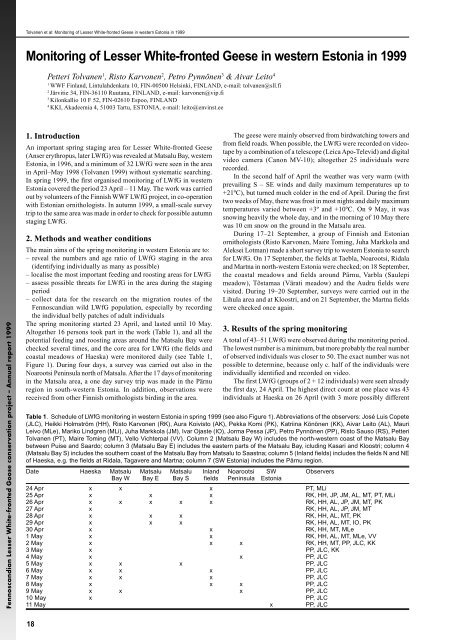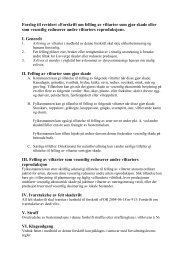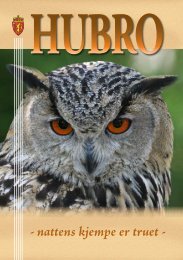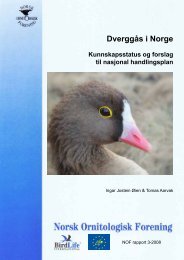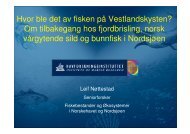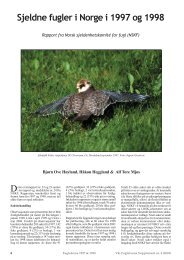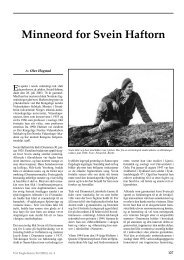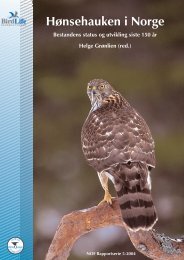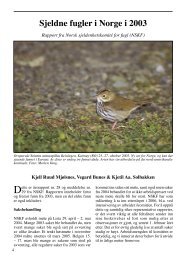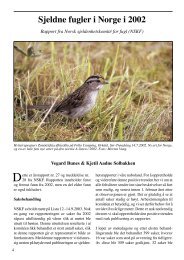Fennoscandian Lesser White-fronted Goose conservation project ...
Fennoscandian Lesser White-fronted Goose conservation project ...
Fennoscandian Lesser White-fronted Goose conservation project ...
You also want an ePaper? Increase the reach of your titles
YUMPU automatically turns print PDFs into web optimized ePapers that Google loves.
<strong>Fennoscandian</strong> <strong>Lesser</strong> <strong>White</strong>-<strong>fronted</strong> <strong>Goose</strong> <strong>conservation</strong> <strong>project</strong> – Annual report 1999<br />
Tolvanen et al: Monitoring of <strong>Lesser</strong> <strong>White</strong>-<strong>fronted</strong> Geese in western Estonia in 1999<br />
Monitoring of <strong>Lesser</strong> <strong>White</strong>-<strong>fronted</strong> Geese in western Estonia in 1999<br />
18<br />
Petteri Tolvanen 1 , Risto Karvonen 2 , Petro Pynnönen 3 & Aivar Leito 4<br />
1 WWF Finland, Lintulahdenkatu 10, FIN-00500 Helsinki, FINLAND, e-mail: tolvanen@sll.fi<br />
2 Järvitie 34, FIN-36110 Ruutana, FINLAND, e-mail: karvonen@vip.fi<br />
3 Kilonkallio 10 F 52, FIN-02610 Espoo, FINLAND<br />
4 KKI, Akadeemia 4, 51003 Tartu, ESTONIA, e-mail: leito@envinst.ee<br />
1. Introduction<br />
An important spring staging area for <strong>Lesser</strong> <strong>White</strong>-<strong>fronted</strong> Geese<br />
(Anser erythropus, later LWfG) was revealed at Matsalu Bay, western<br />
Estonia, in 1996, and a minimum of 32 LWfG were seen in the area<br />
in April–May 1998 (Tolvanen 1999) without systematic searching.<br />
In spring 1999, the first organised monitoring of LWfG in western<br />
Estonia covered the period 23 April – 11 May. The work was carried<br />
out by volunteers of the Finnish WWF LWfG <strong>project</strong>, in co-operation<br />
with Estonian ornithologists. In autumn 1999, a small-scale survey<br />
trip to the same area was made in order to check for possible autumn<br />
staging LWfG.<br />
2. Methods and weather conditions<br />
The main aims of the spring monitoring in western Estonia are to:<br />
– reveal the numbers and age ratio of LWfG staging in the area<br />
(identifying individually as many as possible)<br />
– localise the most important feeding and roosting areas for LWfG<br />
– assess possible threats for LWfG in the area during the staging<br />
period<br />
– collect data for the research on the migration routes of the<br />
<strong>Fennoscandian</strong> wild LWfG population, especially by recording<br />
the individual belly patches of adult individuals<br />
The spring monitoring started 23 April, and lasted until 10 May.<br />
Altogether 16 persons took part in the work (Table 1), and all the<br />
potential feeding and roosting areas around the Matsalu Bay were<br />
checked several times, and the core area for LWfG (the fields and<br />
coastal meadows of Haeska) were monitored daily (see Table 1,<br />
Figure 1). During four days, a survey was carried out also in the<br />
Noarootsi Peninsula north of Matsalu. After the 17 days of monitoring<br />
in the Matsalu area, a one day survey trip was made in the Pärnu<br />
region in south-western Estonia. In addition, observations were<br />
received from other Finnish ornithologists birding in the area.<br />
The geese were mainly observed from birdwatching towers and<br />
from field roads. When possible, the LWfG were recorded on videotape<br />
by a combination of a telescope (Leica Apo-Televid) and digital<br />
video camera (Canon MV-10); altogether 25 individuals were<br />
recorded.<br />
In the second half of April the weather was very warm (with<br />
prevailing S – SE winds and daily maximum temperatures up to<br />
+21ºC), but turned much colder in the end of April. During the first<br />
two weeks of May, there was frost in most nights and daily maximum<br />
temperatures varied between +3º and +10ºC. On 9 May, it was<br />
snowing heavily the whole day, and in the morning of 10 May there<br />
was 10 cm snow on the ground in the Matsalu area.<br />
During 17–21 September, a group of Finnish and Estonian<br />
ornithologists (Risto Karvonen, Maire Toming, Juha Markkola and<br />
Aleksei Lotman) made a short survey trip to western Estonia to search<br />
for LWfG. On 17 September, the fields at Taebla, Noarootsi, Ridala<br />
and Martna in north-western Estonia were checked; on 18 September,<br />
the coastal meadows and fields around Pärnu, Varbla (Saulepi<br />
meadow), Tõstamaa (Värati meadow) and the Audru fields were<br />
visited. During 19–20 September, surveys were carried out in the<br />
Lihula area and at Kloostri, and on 21 September, the Martna fields<br />
were checked once again.<br />
3. Results of the spring monitoring<br />
A total of 43–51 LWfG were observed during the monitoring period.<br />
The lowest number is a minimum, but more probably the real number<br />
of observed individuals was closer to 50. The exact number was not<br />
possible to determine, because only c. half of the individuals were<br />
individually identified and recorded on video.<br />
The first LWfG (groups of 2 + 12 individuals) were seen already<br />
the first day, 24 April. The highest direct count at one place was 43<br />
individuals at Haeska on 26 April (with 3 more possibly different<br />
Table 1. Schedule of LWfG monitoring in western Estonia in spring 1999 (see also Figure 1). Abbreviations of the observers: José Luis Copete<br />
(JLC), Heikki Holmström (HH), Risto Karvonen (RK), Aura Koivisto (AK), Pekka Komi (PK), Katriina Könönen (KK), Aivar Leito (AL), Mauri<br />
Leivo (MLe), Mariko Lindgren (MLi), Juha Markkola (JM), Ivar Ojaste (IO), Jorma Pessa (JP), Petro Pynnönen (PP), Risto Sauso (RS), Petteri<br />
Tolvanen (PT), Maire Toming (MT), Vello Vichterpal (VV). Column 2 (Matsalu Bay W) includes the north-western coast of the Matsalu Bay<br />
between Puise and Saardo; column 3 (Matsalu Bay E) includes the eastern parts of the Matsalu Bay, icluding Kasari and Kloostri; column 4<br />
(Matsalu Bay S) includes the southern coast of the Matsalu Bay from Matsalu to Saastna; column 5 (Inland fields) includes the fields N and NE<br />
of Haeska, e.g. the fields at Ridala, Tagavere and Martna; column 7 (SW Estonia) includes the Pärnu region.<br />
Date Haeska Matsalu Matsalu Matsalu Inland Noarootsi SW Observers<br />
Bay W Bay E Bay S fields Peninsula Estonia<br />
24 Apr x x x PT, MLi<br />
25 Apr x x x RK, HH, JP, JM, AL, MT, PT, MLi<br />
26 Apr x x x x x RK, HH, AL, JP, JM, MT, PK<br />
27 Apr x RK, HH, AL, JP, JM, MT<br />
28 Apr x x x RK, HH, AL, MT, PK<br />
29 Apr x x x RK, HH, AL, MT, IO, PK<br />
30 Apr x x RK, HH, MT, MLe<br />
1 May x x RK, HH, AL, MT, MLe, VV<br />
2 May x x x RK, HH, MT, PP, JLC, KK<br />
3 May x PP, JLC, KK<br />
4 May x x PP, JLC<br />
5 May x x x PP, JLC<br />
6 May x x x PP, JLC<br />
7 May x x x PP, JLC<br />
8 May x x x PP, JLC<br />
9 May x x x PP, JLC<br />
10 May x PP, JLC<br />
11 May x PP, JLC


